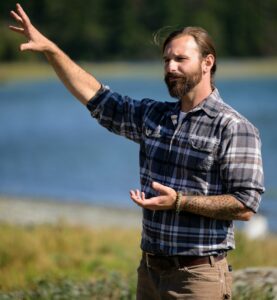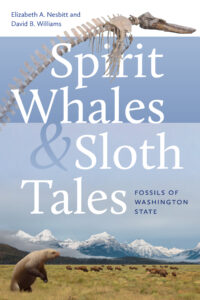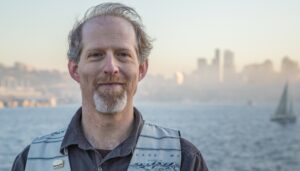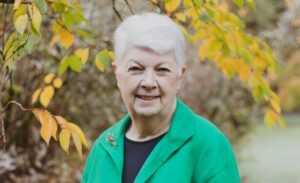
The Lecture
David Brownell, Executive Director of the North Olympic History Center, discussed the shifting “paleochannels” of the Dungeness River and established an environmental and anthropological framework to reach a better understanding of the history of the Dungeness River since the end of the last ice age.
During the last glacial epoch, the Dungeness River discharged its alluvium and built a large depositional complex that extends from the mountain front at Bell Hill north to and including the Dungeness Spit, an intriguing feature on its own (see side image).
We looked at archaeological, geological, and other evidence to “recreate” the landscape of the North Olympic Peninsula as it adapted to changes in climate, biology, and other factors.
 The Speaker
The Speaker
David Brownell moved to Washington in 2015 to take a position as the Cultural Resources Specialist for the Jamestown S’Klallam Tribe. During his time with the Jamestown Tribe, he was responsible for government-to-government consultation with federal, state, and local agencies regarding impacts to cultural sites; curation of the Tribe’s artifact and archival collections; repatriation of ancestral remains and artifacts; education, outreach, and much more. He also worked extensively with Jefferson Land Trust’s conservation team to secure and protect the Tamanowas Rock Sanctuary, and to educate and train Land Trust staff members.
As Executive Director of the North Olympic History Center, he manages a collection of thousands of photos, artifacts, books and more. We are currently digitizing our collections and making them available to the public at www.nohc.catalogaccess.com, as well as planning exhibits and programs for 2024. On the side, I have a small farm in Sequim where I raise goats, chickens, and lots of fruits and veggies.



 David Williams is an author, naturalist, and tour guide whose award-winning book, Homewaters: A Human and Natural History of Puget Sound is a deep exploration of the stories of this beautiful waterway. He is also the author of Too High and Too Steep: Reshaping Seattle’s Topography, Stories in Stone: Travels Through Urban Geology, as well as Seattle Walks: Discovering History and Nature in the City. Williams is a Curatorial Associate at the Burke Museum and writes a free weekly newsletter, the Street Smart Naturalist (
David Williams is an author, naturalist, and tour guide whose award-winning book, Homewaters: A Human and Natural History of Puget Sound is a deep exploration of the stories of this beautiful waterway. He is also the author of Too High and Too Steep: Reshaping Seattle’s Topography, Stories in Stone: Travels Through Urban Geology, as well as Seattle Walks: Discovering History and Nature in the City. Williams is a Curatorial Associate at the Burke Museum and writes a free weekly newsletter, the Street Smart Naturalist (